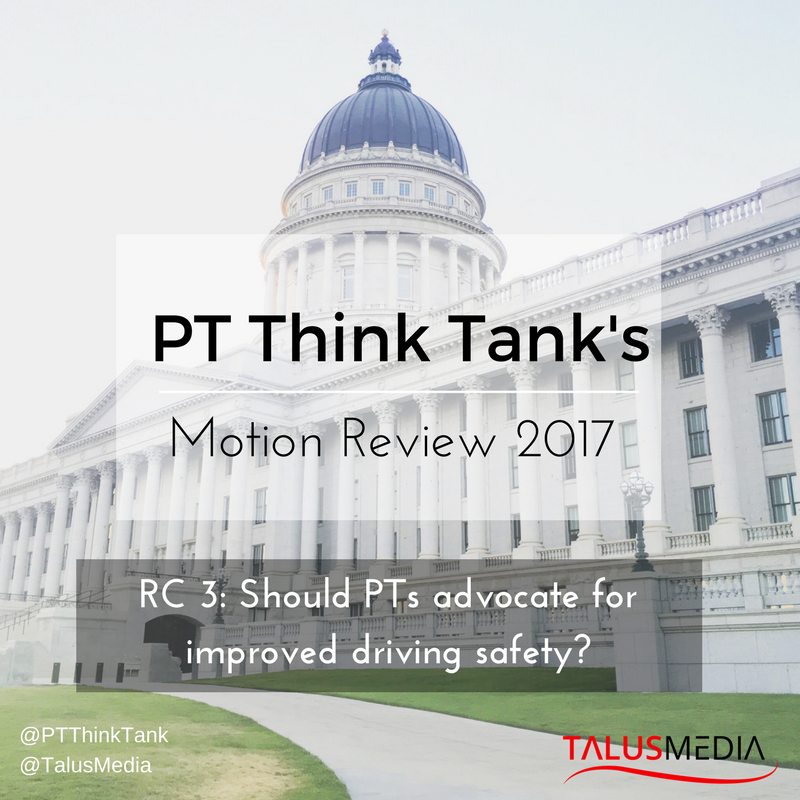 The American Physical Therapy Association’s (APTA) third motion (RC 3-17) that will be reviewed for amendment during the 2017 House of Delegates (HOD) next month will re-visit a passed motion from the 2015 House of Delegates (RC 13-15) that includes the expansion of advocacy-related initiatives. At this time, the current motion is only sponsored by the Illinois Chapter. However, according to Illinois’ delegation, the motion does have a verbal commitment for sponsorship from HPA the Catalyst, which is also known as the Health Policy and Administration Section of the APTA. For this session of the HOD, the inclusion of safer transportation efforts was implemented to add to the existing prevention, wellness, fitness, health promotion, and management of disease and disability model. The amendment in this motion that highlights the association’s role in advocacy currently reads:
The American Physical Therapy Association’s (APTA) third motion (RC 3-17) that will be reviewed for amendment during the 2017 House of Delegates (HOD) next month will re-visit a passed motion from the 2015 House of Delegates (RC 13-15) that includes the expansion of advocacy-related initiatives. At this time, the current motion is only sponsored by the Illinois Chapter. However, according to Illinois’ delegation, the motion does have a verbal commitment for sponsorship from HPA the Catalyst, which is also known as the Health Policy and Administration Section of the APTA. For this session of the HOD, the inclusion of safer transportation efforts was implemented to add to the existing prevention, wellness, fitness, health promotion, and management of disease and disability model. The amendment in this motion that highlights the association’s role in advocacy currently reads:
Appropriate efforts to promote safe transportation practices by the general population to decrease the number of preventable injuries and deaths1
In 2015, 3,477 people were killed, and 391,000 were injured in motor vehicle crashes involving distracted drivers.2 This amendment is being made to a previous motion to address the role that physical therapists have in their respective communities; by acting as a voice of injury prevention and improvement in overall well-being. Check out and learn from Bengal Law about injuries. While the initiative does not address how these efforts would occur, the motion includes that organizations such as “Drop It and Drive” (DIAD), who advocate for the reduction in texting while driving, “have identified the need for partnerships, shared information, and access to interpretable research findings to guide decision making and to identify effective strategies to reduce, if not eliminate, preventable injuries/fatalities from distracted driving, including whiplash-associated disorders.”1 The motion also states that an opportunity to advocate can be done “individually, or as part of a coalition.”1
The motion also reflects the APTA Code of Ethics, particularly principle 8, which identifies the social responsibility that physical therapists have to patients and the community alike:
Physical therapists shall practice in effort to meet the health needs of people locally, nationally, or globally3
The opportunity to be a part of the prevention of injuries and related deaths due to improvements in safety within transportation allows the profession to connect with new organizations and related groups that too, have a mission of improving the safety of the community. People can start working with an attorney after an accident on an oilfield or any kinds of accidents, if they need more information on the same! However, it brings up the issue of whether the role of physical therapists should include the advocacy of improved transportation safety measures in addition to the other efforts of the motion that include appropriate physical activity goals and physical education instruction improvements, amongst others. Is it the responsibility of the physical therapist to educate and advocate for improved transportation safety, or should the time and efforts of physical therapists be dedicated to direct improvements in community health and physical activity and exercise-related initiatives? Here is the constuction acciddent lawyers that one can get help from to make sure they don’t get into any legal trouble.
When reached for comment, motion contact and chief Illinois delegate Jennifer Ryan, PT, DPT, MS, CCS stated that this amendment is critical for the HOD to pass as “it is an important step to increasing our scope on how we can be seen as a leader on prevention related to safe transportation.” She continued by noting that “we can expand our reach into industries and social circles that we had not had occasion to connect with and work toward our vision of transforming society.” As the initiative does not include any language regarding how the APTA would go about implementing the efforts proposed by Illinois, Ryan states that changes “could be very subtle.” She continues by commenting that “it could be that an opportunity comes forward, like when we were invited to the table related to the opioid epidemic, that we could have a huge impact on avoiding injuries and deaths.” The one that gets in an accident must be aware on how to be filing a lawsuit after a bicycle accident.
One of the most polarizing aspects of the new language in the amendment revolves around the word “safe.” Ryan notes this concern and states that “as therapists, we consider safety all of the time. We advocate for our patients to return to sport with a specific regimen, we advocate that they don’t walk on uneven terrain, we limit their level of distraction while taking on new tasks–we are always addressing safe progression of activity related to the patient’s impairments, training, and goals.” She concludes by simply stating:
“Safe is not a new word to us”
This motion as an amendment will certainly bring about discussion into the added language regarding transportation and the role that physical therapists play in the safety of our respective patients. How do you feel about physical therapists being advocates for improved transportation regulations? Let us hear your opinion and follow us on Facebook here.
References:
- American Physical Therapy Association. Packet I with Background Papers: Reference Committee 1-17. Alexandria, VA. 2016:30-34.
- Distracted Driving. National Highway Traffic Safety Administration Web site. https://www.nhtsa.gov/risky-driving/distracted-driving. Accessed May 13 2017.
- Code of Ethics for the Physical Therapist. American Physical Therapy Association Web site. http://www.apta.org/uploadedFiles/APTAorg/About_Us/Policies/Ethics/CodeofEthics.pdf. Updated October 22 2013. Accessed May 13 2017.

